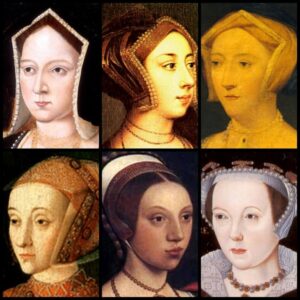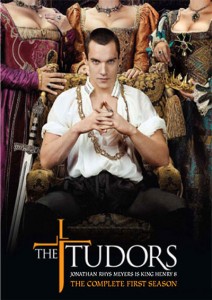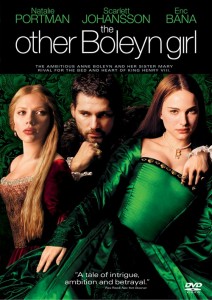 Thank you to author and historian Conor Byrne for writing this guest article for us today.
Thank you to author and historian Conor Byrne for writing this guest article for us today.
Yesterday, the Guardian published a provocative article entitled “Six Wives with Lucy Worsley: Why TV shows are for the chop.” The article, which reviewed the Oxford-educated presenter’s new television series on Henry VIII’s consorts, was highly critical. Joel Golby deemed the show ‘awful, tedious history’ and ‘Game of Thrones without any of the good bits’. The comment section indicated that many agreed with Golby’s scathing analysis. One lambasted the ‘tedious focus’ of ‘Henry VIII’s dysfunctional spouse-making’; another questioned why ‘in the case of Henry VIII we re-visit him and his wives again and again.’
In fairness, these criticisms are not new. The eminent historian and presenter Dr David Starkey objected, some years ago, to what he perceived as the ‘feminisation’ of history – by which he meant the widespread popular interest, shared by professional historians, in Henry’s wives and mistresses, rather than in the ministers, politicians and scholars at court. Never mind that Starkey himself produced a biography of Henry’s wives in 2004, and later presented a television series on them. Other historians, such as Linda Porter, have suggested that the public is tiring of the Tudors and are moving towards the Stuarts – her Royal Renegades, detailing the lives of Charles I’s children, was published in October of this year. Other historians, including Leanda de Lisle and Anna Whitelock, have moved away from Tudor monarchs in favour of the issues of the English succession that brought James VI of Scotland to the throne.
Popular writers and novelists undoubtedly deserve credit for influencing the general public’s historical interests. Philippa Gregory, who published a series of novels about the Tudor court, later turned to the houses of York and Lancaster, embroiled in the fifteenth-century Wars of the Roses. The success of these novels, including The White Queen, led to a BBC drama adaptation by the same name. Conn Iggulden, more recently, has published a series of successful novels about the same period, albeit not from the exclusively female perspective that Gregory favours. As mentioned earlier, there appears to be, at present, a much greater interest among historians in the Stuarts, and it is possible that this interest will be replicated in the world of fiction. Perhaps, indeed, we are moving away from the Tudors in favour of their Plantagenet ancestors, or in favour of their Stuart successors.
And yet, two television series about Henry’s six wives have arrived this year. The first, presented by Suzannah Lipscomb and Dan Jones, was followed by that of Worsley’s. The BBC and other television channels have also presented television documentaries about other aspects and figures of the Tudor dynasty, including Henry VII (the ‘winter king’), Elizabeth I and Mary, Queen of Scots, and Thomas Cromwell (the latter likely in response to increased interest in the Tudor minister as a result of the success of Hilary Mantel’s Wolf Hall). But the interest in Henry’s wives appears second to none. Millions flock to Hampton Court Palace, the Tower of London, Hever Castle, Westminster Abbey, Sudeley Castle and Windsor Castle every year – and for many, it is because of the association of these palaces and fortresses with the six wives. Perhaps playing on this interest, consider In the Footsteps of Anne Boleyn, and In the Footsteps of the Six Wives of Henry VIII, both written by Sarah Morris and Natalie Grueninger, which provide an exhaustive list of properties associated with Henry’s queens, mainly in England but also in Spain, France and Germany. Lissa Chapman’s Anne Boleyn in London, moreover, offers a more specific consideration of the properties in which a Tudor queen lived and died.

In little more than a century, between 1485 and 1603, England was convulsed by religious turbulence and political revolution. This period witnesses the break with the Roman Catholic Church and the triumph of the English Reformation. It encompasses incredible military, diplomatic, political, social, cultural and artistic developments, including reforms made to the navy, the flowering of English literature (plays, poetry and religious literature), the emergence of the theatres, global expansion, and voyages to the New World. Incredible figures abound from all walks of life, from the kings to the poets, the queens to the lawyers, the scholars to the politicians, the playwrights to the pirates, the reformers to the recusants, the preachers to the schoolmasters, the actors to the authors. We have the expansion of knowledge, with the development of natural philosophy (‘science’) that culminates in the so-called Scientific Revolution of the seventeenth century. We have the flowering of poetry, plays and religious texts; we have the first queen regnants in Scotland; we have turbulence in Ireland and Scotland; we have far-reaching governmental reforms made across the kingdom, including in Wales; we have the first contacts made with Russia and we have assassination plots, executions, monstrous births, religious violence, usurpations and rebellions.
We have a pregnant woman on the Channel Islands cruelly forced in the flames for her heresy, her baby thrown in after her. We have a merchant tailor dying in suspicious circumstances in a London cell, the clergy implicated, the so-called Hunne affair. We see London apprentices rising in anger, rebelling; we observe northern rebels fighting for their religion, furious with what they perceive as ungodly reforms made by the ‘evil counsellors’ at court and the displacement of the rightful heir in the succession. We witness playwrights congregating in inns and taverns, developing their works, seeking patronage. We have a queen deprived of her crown and kingdom, humiliated, tried and executed in a lonely castle, forsaken by her son. We have a royal family extinguished and stamped out by a ruthless dynasty, the white rose of York ripped from the hedgerows for the final time. We have two brothers mercilessly executed within several years of one another, their wives having used jewellery to fight for precedence at court. We have foreign ambassadors influencing the decisions of their governments, we have pretenders raising support across the shires, arriving in harbours and seeking the throne. We have women giving birth to cats, we have widespread iconoclasm and the destruction of medieval Catholicism, we have voyages across the Atlantic, we have royal princesses confined to lonely palaces and houses, separated from their families and friends, starving to death, deprived of their husbands, or executed on scaffolds. We have a young woman, forgotten in exile, dying at the bottom of a flight of stairs; as a result, the virgin queen can never marry her true love. We have the so-called miserly king who pursues security and financial stability, who produces several children, enjoys a loving relationship with his wife, defeats all pretenders and achieves governmental efficiency. We have his son, who reforms the navy, seeks foreign glory, builds a series of castles and fortresses in defence of his kingdom, authors religious tracts, pursues unity with Scotland and involves himself in a whole host of architectural projects. We have the young Protestant boy who authorises the destruction of his kingdom’s churches, whitewashes the walls, rids the parishes of Catholic idolatry and chooses to remove his sisters from the line of succession. We have the Tudor queens regnant, who pursue a policy of terror against their cousins and rivals, encompassing imprisonments, executions, banishment and disgrace; who sentence hundreds to death for their religious crimes, who send armies abroad to fight in foreign battles, who act as patrons of poets and playwrights, who give speeches to inculcate loyalty in their subjects to their queen, the mother of the kingdom, and who ultimately, as sisters, loathe one another. We have not just England, but Scotland, Ireland, Wales and briefly Spain.
And yet… despite all this, we return to the stories of six individuals: Henry VIII and his six consorts. Is it because their stories continue to resonate with us today, almost five hundred years later, and if so, why? Is it the courage and resilience of Katherine of Aragon, who fought endlessly for her daughter’s rights and for her marriage, ultimately dying alone, a virtual prisoner, in a lonely Cambridgeshire castle? In her own lifetime, Katherine’s subjects rallied to her, just as she had rallied the English soldiers to her cause in 1513, to defeat the Scots, her husband’s traditional enemy. Women sympathised with her, for they knew what it was to experience losses in childbirth, to experience a husband’s infidelity and loss of interest. Even today, perhaps, women can relate to Katherine.
But most of all, Anne Boleyn is the queen that the general public wants to hear about. We cannot get enough of her. Novels and biographies are written about her every year; television and films produced about her; news of her portraiture features in all of the major British newspapers. It is hard to imagine that happening for any of the other wives. And yet, she died in obscurity and shame, a traitor to her husband, a monstrous lecher, an adulteress, a suspected would-be murderess. In her own lifetime, she polarised opinion. Her defenders hailed her as a sixteenth-century Esther, a generous and sincere reformer who did much to further evangelicalism in England. In doing so, she contributed to the development of her daughter’s religious establishment. Anne’s enemies identified her as an evil seductress, probably deformed in appearance, who lured her brother into committing incest with her. These opposing sets of views have mostly been discarded today, in favour of a more nuanced understanding, but even so, notions of witchcraft and rampant sexuality continue to be associated with Anne as individuals visit Hampton Court and Hever. Perhaps, in part, due to the success of The Other Boleyn Girl and The Tudors, which favour sensationalism over accuracy. And yet, when all is said and done, the competing versions of Anne as martyr, witch, saint and wh*re are ultimately discarded in favour of Anne the tragic victim, in that haunting, poignant scene on the scaffold, betrayed by her husband.

The stories of the successors of Katherine of Aragon and Anne Boleyn lack the religious upheaval, political revolution and personal drama that, perhaps, ensure the greater interest in Henry’s first two wives. Jane Seymour, Anne of Cleves and Katherine Howard are, in Starkey’s words, ‘creatures of the moment’, but even so, they have their admirers and defenders, their detractors and their slanderers. Internet battles pitch ‘Team Anne’ against ‘Team Jane’, while Hilary Mantel’s novels have offered to us a new version of Jane as an intelligent, resourceful and observant intriguer at court. However, the scarcity of actual facts about Jane, as observed in the attempts to write modern biographies of her, ultimately ensures that she remains an elusive figure – tantalising, in her mystery, but frustrating, in that we can’t form a real sense of who she was. Perhaps, in a way, she is the most elusive of Henry’s queens, and is, therefore, the perfect subject for a novel.
Anne of Cleves, the so-called ugly queen, got pushed aside in favour of her younger, beautiful maid-of-honour – but what’s often forgotten is the widespread admiration and respect with which Anne was greeted in England, from the moment of her arrival in a December winter to her death in obscurity during the reign of her stepdaughter. Her marriage to Henry was the shortest, but she is perhaps one of the most misunderstood of his wives. Even today, she is often viewed with a snigger as the Flanders mare, even though that name was only coined the following century, and the causes of the failure of her marriage continue to be woefully misunderstood. Only recently are we coming to view Katherine Howard as a victim of neglect and possibly of abuse, a young girl in a large household in which predatory behaviour could – and did – flourish. Because we seem to view youth as synonymous with foolishness, we ignore her intercessions, her patronage and her ceremonial activities and focus on her doomed encounter with her husband’s courtier as evidence of her flightiness. While happy to regard Anne Boleyn as innocent, because she did not confess to any crime while in the Tower, we ignore Katherine’s statement that she was not guilty of adultery and instead allude to her as ‘the guilty one’ or the ‘wh*re’.
And last but not least? Katherine Parr, the first queen to write her own books, the one of all Henry’s wives, perhaps, who most influenced her stepdaughter Elizabeth’s model of queenship (whether, and how, she influenced her other stepdaughter Mary is an issue that is often not addressed). The one who married Henry, despite her love for Thomas Seymour; the one who ultimately got her happy ending, but was then betrayed by her husband. The Duchess of Cornwall’s favourite wife, apparently.
Could any of these women have envisaged the impact they would continue to have hundreds of years after their deaths? Almost certainly not. Two of them died in shame and disgrace, hastily buried in the Tower chapel. Anne Boleyn would never have known her daughter would one day reign in triumph. One died a virtual prisoner, in exile, as if she were a traitor to her kingdom when, in fact, she saw herself as its saviour. One died, forgotten, but widely respected, even admired. Another died shortly after giving birth to a short-lived daughter, raging at her husband. And another died after producing a son; she, alone of all the six, lies buried with that most enigmatic king, Henry VIII, at Windsor.
Conor Byrne studied History at the University of Exeter and is currently studying for a Masters. He is the author of Katherine Howard: A New History and the forthcoming Queenship in England. He specialises in late medieval and early modern European history, with a focus on gender, sexuality and the monarchy.
Episode 1 of Six Wives with Lucy Worsley can be viewed on YouTube – click here – and if you’re interested in learning more about Henry’s six wives then MedievalCourses.com offers a 7-unit online course, “The Six Wives of Henry VIII: Monarchy and Matrimony in Tudor England”, by historian Gareth Russell, click here for details.